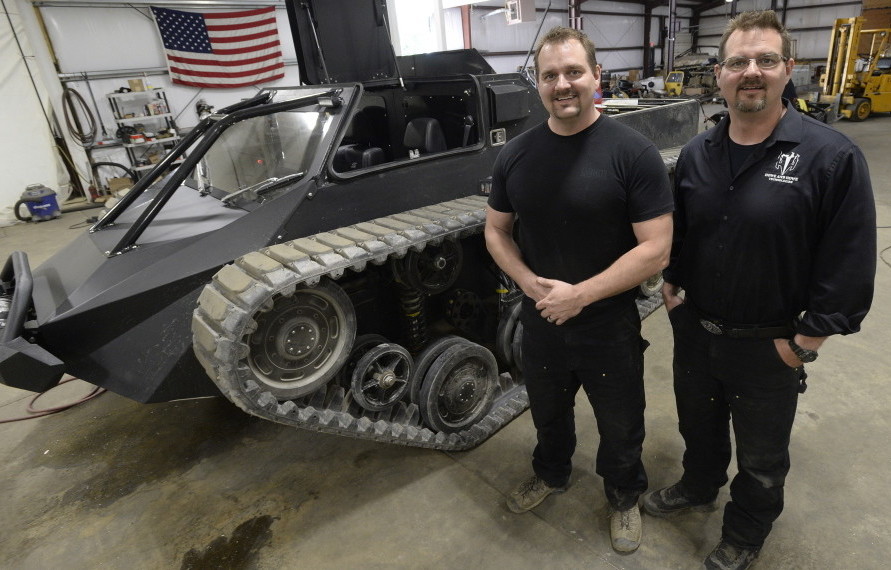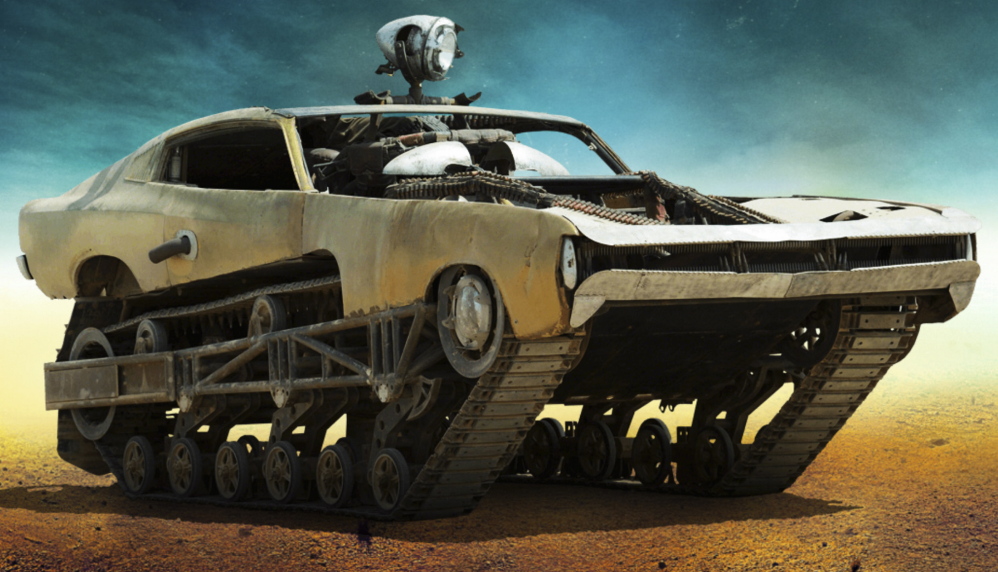WATERBORO — “Mad Max: Fury Road” has its share of stars, but for Geoff and Mike Howe, nothing in the film chews up the scenery like The Peacemaker.
The twin brothers created the nasty tracked vehicle in Waterboro, where large metal parts and mean-looking half-completed vehicles fill much of their large manufacturing space on Main Street. Their Howe and Howe Technologies makes an array of outsized and powerful high-tech contraptions, from walk-behind robots that soldiers use to shield themselves against roadside bombs to extreme firetrucks that can reach remote wildfires.
And lately, Hollywood has come calling, with a vehicle for a GI Joe movie and now Mad Max, where the producers eschewed computer-generated pixels for the real things roaring across the desert.
“They wanted to go old school on this,” Geoff Howe said. “They said, ‘It’s going to be carnage and it’s going to be real carnage, not CG.’ ”
Geoff Howe said the brothers were nearly beside themselves when the producers asked for one of the company’s Ripsaw tanks.
“They said they wanted the most badass, most powerful Ripsaw we ever made. We come from the era of ‘Mad Max,'” he said, referring to the original 1979 movie. “We kind of had to pinch ourselves.”
Geoff Howe declined to say what they were paid to make the vehicle, citing a confidentiality agreement the company signed with the producers.
The tracked vehicle that provides the guts of The Peacemaker is called the Ripsaw. Howe and Howe Technologies’ original product, it was built as a lightweight tank for the military and is designed more for moving people and things across difficult terrain than for combat.
The Peacemaker earned an extended action sequence in the movie and has invited glowing reviews from publications ranging from Britan’s Daily Mail to Popular Mechanics, which called the vehicle a “gonzo tank” that’s the “real star” of the movie.
The producers of “Mad Max: Fury Road,” which was released this month, mounted a 1960s-style muscle car atop the open-framed tank and set it loose to race across the post-apocalyptic landscape in the latest installment of the Road Warrior film franchise.
But the vehicle’s roots go back to the Howe brothers’ more peaceful boyhood in southern Maine, where the fraternal twins built a log cabin with just an ax when they were 6 years old and took apart their mother’s can openers to fashion robotic arms.
After college – Mike Howe graduated from Bowdoin and Geoff Howe attended the University of Maine, but dropped out before graduating – both found themselves working in construction, but still longing for the days when they could tinker on robots, engines and motors. That became a possibility in 2005, when they incorporated after developing the Ripsaw.
They outfitted one to be driven remotely and entered it in the DARPA Grand Challenge, a Defense Department-funded competition to help the military get a look at cutting-edge research in autonomous vehicles. Geoff Howe said they were the only tracked vehicle in the competition and finished 38th out of 175 teams, but were hamstrung from developing the Ripsaw further because of a lack of funding.
The brothers decided they needed to branch out, developing extreme firetrucks and ambulances for local governments and robotic vehicles for both military and industrial applications. They even came up with a product called the Ripchair, which gives those confined to a wheelchair a way to get off the trails and move through the brush. It’s equipped with a gun rack for hunters and a pole holder for fishing, and the company calls it “the most rugged, most powerful, go anywhere off-road wheelchair ever built.”
The company has sold more than a dozen Ripchairs, Geoff Howe said, which at about $35,000 are sold nearly at cost.
Robots run from about $120,000 to $500,000, depending on how they’re equipped, he said. Models include the Thermite, a firefighting robot; SWAT-bot, a walk-behind robot for use by police special weapons and tactics teams; and tracked robots outfitted with grappling arms, camera gear or even bulldozer blades for remote-controlled landscaping. The Gremlin, equipped with a machine gun, is designed to protect troops from improvised explosives and is “not for private-sector purchase,” the company said.
Extreme firetrucks and ambulances run from $100,000 to $250,000, Geoff Howe said, depending on equipment, and the latest version of the Ripsaw goes for about $300,000, he said, including the 6.6 liter, 500-horsepower engine.
And the market these days goes beyond movie-makers and local public safety departments.
The company is putting the finishing touches on a personal Ripsaw that will be shipped next week to a vehicle enthusiast in Europe – Geoff Howe said the buyer insisted that his name and the price not be disclosed.
And the Discovery Channel regularly sends a film crew to Waterboro to see what the two are building.
“They call up and say, ‘What have you guys been up to?’ ” Mike Howe said. On Thursday, an employee was putting the Bulldog firetruck through its paces in the woods for the channel’s crew.
Geoff Howe said he and his brother never let a setback stop them and said the shift from exclusively military products to other markets has been a good one.
The company also has talked to movie producers about making vehicles for other films, although none of the deals is done yet, he said.
“We get calls from all over the world and what’s great about this job is you never know what’s around the corner,” Geoff Howe said. “Our payoff is the future.”
Send questions/comments to the editors.




